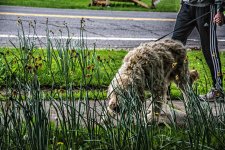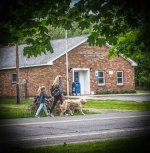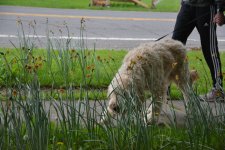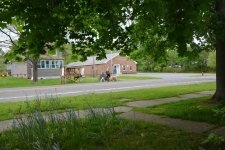Fine tuning lenses can be ineffective on zoom lenses unless you have 1 specific focal length that you wish to optimize. I doubt it is needed since even if off slightly at one zoom end, short or long, it is a small enough aperture lens to give a deeper depth of field. That means, at any distance, the subject can be behind or in front of the optimum focal plane and still be in focus. Where fine tuning is often needed is where lenses have a very wide maximum aperture, smaller f/numbers. Wide apertures have very shallow depth of field so only a narrow range in front and in back of the focusing plane will be in sharp focus. That is especially true of f/1.2 and f1.4 lenses. And even more so with full frame sensors. A zoom lens is more forgiving in focus tolerance because almost all are narrower maximum aperture lenses.
These images are fine, but a bit over contrasty, probably set to Vivid picture control and then when sharpened in post processing they can develop unwanted sharpening artifacts on edges of colors or between light and dark transitions. If you are going to post process it would be better to start with a neutral or Standard Picture Control setting, which will allow more adjustment range before developing unwanted artifacts.
The image loses some detail perception being underexposed. It is about 1/2 stop under exposed if you look at the histogram in your editing software or the original file in the camera. The Green channel is dominate and that is easy to over saturate so it is often good to slightly underexpose a green dominate image so you can selectively increase brightness in post process. The problem with under exposure is that noise quickly becomes a problem in the image and colors are not accurate. Look at the brightest part of the image, the white signs. They are not white but grey due to under exposure.
As mentioned before, detail is lost when the subject is defined by fewer pixels, and the girl and dog are a tiny portion of the total so few pixels have to define all you see of them, no more than 12 square pixels define her head and hair for example. If you were to use a pencil to draw an object and could only use 12 dots to draw it, you would not expect to see very much detail or convey much information. But the eye does a pretty good job of painting an impression in our brains that it is a girl, and has long blonde curly hair. Objects closer have thousands of pixels with which to capture and display a great deal of detail.
Cropping should be limited to adjusting the aspect ratio of the image, but not for zooming in unless you don't mind losing a lot of detail and sharpness. That is why most of us have a camera bag full of lenses that are most appropriate for the subject and distance to get the maximum number of detail defining pixels across the subject. If you used a 300mm lens, she would have appeared sharp and filling about 1/3 rd - 1/2 of the frame. Even a lower quality telephoto lens would allow more detail and resolution than cropping a shorter focal length lens image.
There is another factor, and that is viewer perception. A person sees a distant object and missing data is filled in so we think we see a lot of detail that only appears not to have detail when the image is blown up. It is perfectly natural to have a lot less detail perceived with distant objects so it is usually a better representation of a distant object to be displayed small, in its normal context. It looks more natural.
The surest way to become disappointed with an image regardless of the camera, lens or subject is the terrible habit of Pixel Peeping. Don't do it unless only to find fault such as badly missed focus when viewing on a small screen. Every form or art has an intended viewing distance and inside of or outside of that distance degrades the message or content. Viewing zoomed in reveals nothing about the content and value of an image, and can only tell you things that can reduce your confidence in it. There is no good whatsoever that comes from pixel peeping and makes you delete images that might be very good. View your images at a distance appropriate for seeing the entire image in one take, not scanning eyes across it to see it all. For a 30 inch monitor viewing distance is likely 2.5-3 feet. The real story being told, can be seen and at that distance the detail looks sharp, it IS sharp and leave it alone. Pixel peeping, where you zoom to 100% is betraying the art of photography or painting or any other communications oriented art. Beginners do it, thinking it tells them something they can't see at normal distances. Yes it does but that information it conveys says nothing about a photo as to its ability to convey a story or message. You will progress as a photographer much faster if you avoid that poor habit almost all beginners fall into.
Another related habit that retards progress is the belief that a camera with higher ISO capability makes up for low light. Photography IS light, and shadows, that is all it has to convey and tell a story with. Light is the story and bad light means bad images, regardless of the sensitivity of the camera to bad light, there is less information possible with bad low light. What is bad or good light? Light/shadows that convey your story versus light that obscures your message. Good light might be dim and streaky, or perfect illumination in a studio or anything that propels your intent. Few photographers think much about it so few photos means much to anyone but the ones who took the photo.
Our eyes tell us there is poor color, lack of detail in dim light for a good reason, there really is less information, there really is poor or low color in poor light. Hi ISO does not make up for absent information in the actual scene. If it dark and moody, capture it as dark and moody. More great photos are taken by using the dark as the story telling element. Go look look at an art gallery, not on-line, and notice the painters and photographers use shadow as much as light to convey their message, and the message would be lost if snap style fulled exposed,noise and all. The two biggest weaknesses beginners nurture is pixel peeping and high iso, both work against their story and intent of images.
If you need light, make it or modify it. Before buying a better camera or high end lens, put your money into lighting and learning to use it. Someone who learns lighting is far ahead of someone who learns cameras or lenses. Spending $500 for a good workshop on lighting will put them far ahead of someone who starting at the same level, spends $5000 on lenses and camera. That is not just studio lighting but being aware and being creative in all situations with lighting, even if just reflection from a nearby glazed window, or using angles that allow the sandy beach to fill shadows, or using a flash light for light painting to highlight a subject. Light is the whole point of photography and it is seldom considered as important as it is with those fixated on lenses and camera bodies. Every camera and lens for sale today is perfectly capable of award winning images.
Good luck and have fun...




